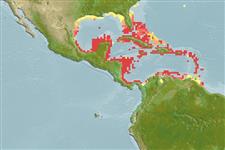Common names from other countries
>
Eupercaria/misc (Various families in series Eupercaria) >
Scaridae (Parrotfishes) > Scarinae
Etymology: Scarus: Greek, skaros = a fish described by anciente writers as a parrot fish; 1601 (Ref. 45335).
More on authors: Bloch & Schneider.
Environment: milieu / climate zone / depth range / distribution range
экология
морской ассоциированный с рифами; пределы глубины 3 - 25 m (Ref. 9710). Tropical; 33°N - 8°N, 98°W - 59°W
Western Central Atlantic: Bermuda, Florida (USA), and Bahamas to northern South America; throughout the Caribbean Sea.
Size / Вес / Возраст
Maturity: Lm ? range ? - ? cm
Max length : 61.0 cm TL самец/пол неопределен; (Ref. 7251); common length : 32.0 cm TL самец/пол неопределен; (Ref. 3802)
колючие лучи спинного плавника (общее число) : 9; членистые (мягкие) лучи спинного плавника (общее число) : 10; колючие лучи анального плавника: 3; членистые (мягкие) лучи анального плавника: 9. Young adults of both sexes dark gray overall, with broad white stripe slightly below mid-side. Super males have upper pectoral fin margin and upper and lower margins of tail dusky with submarginal band of brownish orange (Ref. 26938).
Inhabits coral reefs and adjacent habitats. Feeds on algae scraped from rocks or dead coral. Sleeps in a mucus cocoon (Ref. 9710). Often seen in groups of one super male with several young adults, most of which are probably females (Ref. 26938). A protogynous hermaphrodite (Ref. 55367).
Life cycle and mating behavior
Maturities | размножение | Spawnings | Egg(s) | Fecundities | личинки
Forms permanent harem groups composed of a single male and several smaller females (Ref. 55367). A monandric species (Ref. 55367). Length at sex change = 25.2 cm TL (Ref. 55367).
Robins, C.R. and G.C. Ray, 1986. A field guide to Atlantic coast fishes of North America. Houghton Mifflin Company, Boston, U.S.A. 354 p. (Ref. 7251)
Статус Красного Списка МСОП (Ref. 130435)
CITES (Ref. 128078)
Not Evaluated
Угроза для людей
Reports of ciguatera poisoning (Ref. 30911)
Использование человеком
рыболовство: не имеет хозяйственного значения; аквариум: коммерческий
дополнительная информация
инструменты
Специальные отчеты
Скачать в формате XML
ресурсы в Интернет
Estimates based on models
Preferred temperature (Ref.
115969): 26.2 - 28.2, mean 27.4 (based on 528 cells).
Phylogenetic diversity index (Ref.
82804): PD
50 = 0.5000 [Uniqueness, from 0.5 = low to 2.0 = high].
Bayesian length-weight: a=0.01445 (0.00686 - 0.03044), b=3.03 (2.86 - 3.20), in cm Total Length, based on LWR estimates for this Genus-body shape (Ref.
93245).
Trophic level (Ref.
69278): 2.0 ±0.00 se; based on food items.
устойчивость к внешним воздействиям (Ref.
120179): высокий, минимальное время удвоения популяции до 15 месяцев (K=0.6).
Fishing Vulnerability (Ref.
59153): Low to moderate vulnerability (28 of 100).
